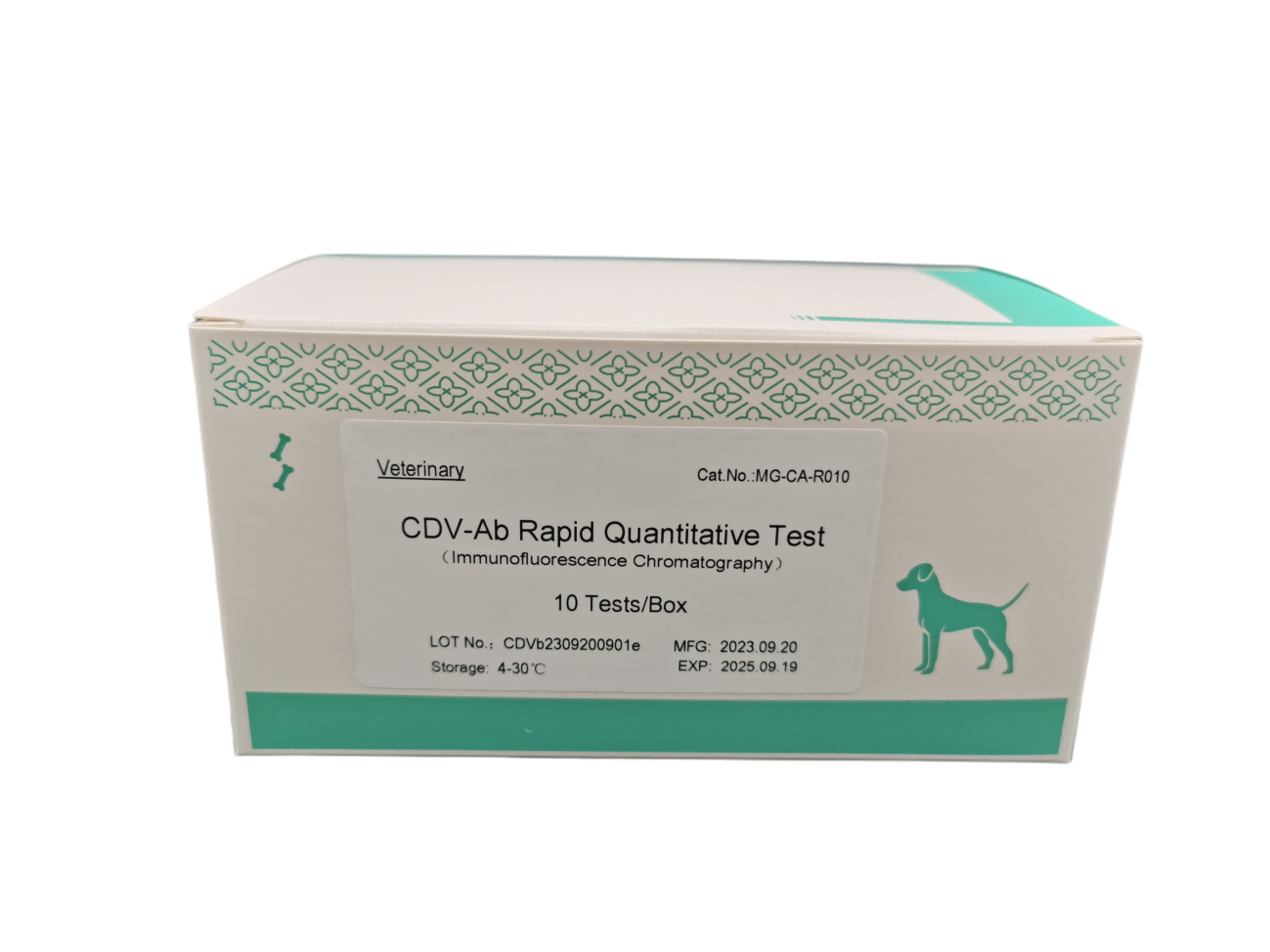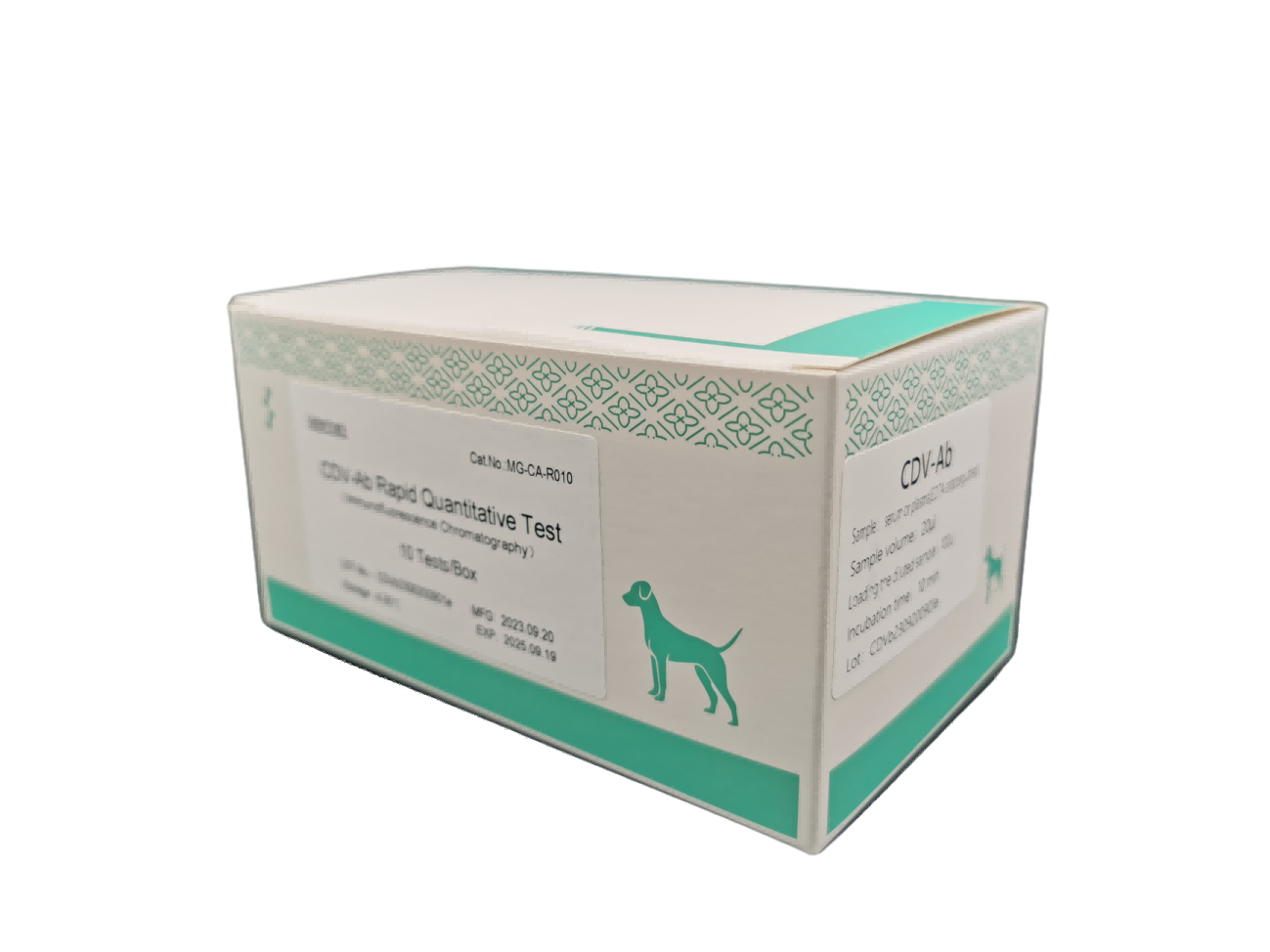



Key attributes

SPECIFICATION
10 Tests/Box
Cat. No.: MG-CA-R018
INTENDED USE
The cCortisol test is a fluorescence immunoassay designed for use with an Immunofluorescence Analyzer to quantitatively measure cCortisol levels in canine serum or plasma specimens.
For in vitro diagnostic use only. Professional use only.
TEST PRINCIPLE
This test utilizes a quantitative competitive fluorescence immunoassay technique. The fluorescence intensity corresponds to the amount of cCortisol present, and the concentration is reported in μg/dL or nmol/L.
MATERIALS INCLUDED
Individual Sealed Pouches (10)
Test Device (1 per pouch)
Desiccant Pouch (1 per pouch)
ID Chip (1)
Instructions for Use (1)
cCortisol Sample Buffer Tubes (10)
Pipette Tips (10)
Materials Required but Not Provided:
Immunofluorescence Analyzer
Timer
Pipette
Centrifuge
STORAGE AND STABILITY
Store the test kit between 4°C and 30°C until the expiration date.
The test should be conducted between 18°C and 28°C once the pouch is opened.
Perform the test within 30 minutes of opening the pouch.
SPECIMEN COLLECTION AND PREPARATION
Suitable specimens: serum or plasma (EDTA anticoagulant recommended).
Separate serum or plasma from blood within 3 hours of collection. If hemolysis occurs, collect a new specimen.
Perform the test immediately after collection if possible. Otherwise, store the specimen at 2°C to 8°C for up to 72 hours, or below -20°C for long-term storage.
Bring all materials to room temperature before testing. Thaw frozen specimens completely and mix thoroughly. Avoid repeated freeze-thaw cycles. Only clear, non-hemolyzed specimens should be used.
TEST PROCEDURE
Set the Test Device on a clean, level surface.
Insert the ID Chip into the analyzer and ensure the Test Device lot number matches the ID Chip number.
Pipette 50 μL of prepared sample into the cCortisol Sample Buffer tube and mix gently (avoid foaming).
Pipette 100 μL of the mixed sample into the sample well (S) of the test device.
Choose test mode:
Standard Test: Insert the Test Device into the analyzer immediately and click "Start Test". Select "Serum/Plasma". The analyzer will automatically provide results.
Quick Test: Start a timer after adding the sample to the Test Device. Allow the test to incubate at room temperature (18°C - 28°C) for 10 minutes, then insert the Test Device into the analyzer and click "Start Test". Select "Serum/Plasma".
Results are displayed on the screen and can be printed automatically or manually.
QUALITY CONTROL
Each cCortisol Rapid Quantitative Test includes an internal control to meet routine quality control standards. If the internal control fails, the analyzer will display an error message, indicating the need to repeat the test.
INTERPRETATION
Reference range for cCortisol in canine serum or plasma:
ACTH Stimulation Test
| ACTH Before Use (nmol/L) | Suggestion | ACTH After Use (nmol/L) | Suggestion |
|---|---|---|---|
| < 55 | Possible adrenal insufficiency | < 55 | Possible adrenal insufficiency |
| 55 - 166 | Normal | 55 - 166 | Suspected |
| > 166 | High | 166 - 498 | Normal |
| 498 - 663 | Suspected | ||
| > 663 | Hyperadrenocorticism |
LDDST
| 4-Hour Cortisol (nmol/L) | 8-Hour Cortisol (nmol/L) | Suggestion |
|---|---|---|
| -- | < 28 | Normal |
| 28 - 39 | 28 - 39 | Suspected |
| > 39 & > 50% base value | > 39 & > 50% base value | Hypofunction of adrenal cortex |
| < 39 & < 50% base value | > 39 & > 50% base value | PDH |
HDDST
| 4-Hour Cortisol (nmol/L) | 8-Hour Cortisol (nmol/L) | Suggestion |
|---|---|---|
| < 39 & < 50% base value | > 39 & > 50% base value | PDH |
| > 39 & > 50% base value | < 39 & < 50% base value | PDH |
| > 39 & > 50% base value | > 39 & > 50% base value | Further testing required |
Detection range: 28 ~ 1700 nmol/L
Conversion factor: 1 nmol/L = 0.036 μg/dL
Each laboratory should establish a reference range based on the population being evaluated.
WARNINGS AND LIMITATIONS
For in vitro diagnostic use only.
Inspect all packaging before use.
Do not use the test if the packaging is damaged or the vial is leaking.
Do not use expired test devices.
Use a new pipette tip for each specimen.
Technical or procedural errors, as well as interfering substances in the blood, may affect test results.
